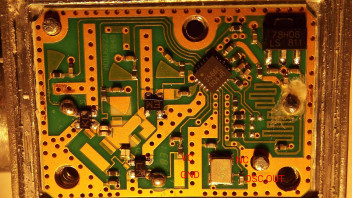I have been using a cheap TRIAX single LNB to date, it's got a PLL oscillator but can still drift quite a lot.
As I had a spare I thought I would have a look inside. The unit seems to use a small surface mount TXCO of some description, the only way I could see some of the details is by taking a picture.
As it uses one of these oscillator blocks, I think it could be easy to modify by bringing a small cable through the lid!

I read a few conversions from crystals to external and discussions about driving single or double ended etc.
I think I have marked the osc correctly, does anyone have a data sheet on the 3566E
It may not be the best idea but something I think I will have a play with.
Adrian
![]()

